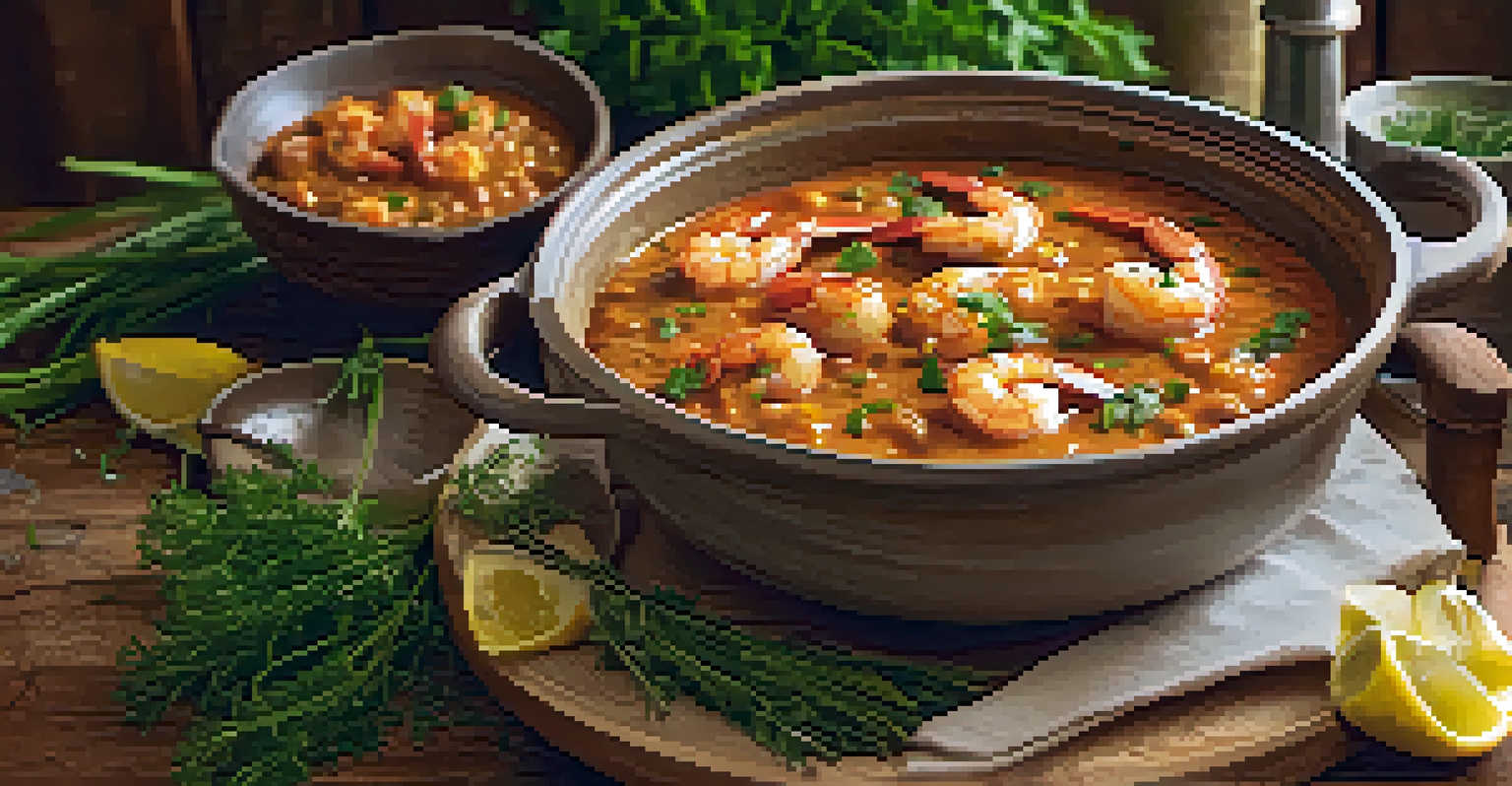The Influence of French Cuisine on New Orleans' Food Scene

The French Influence on New Orleans' Culinary Foundations
New Orleans is a city known for its rich culinary heritage, and French cuisine plays a pivotal role in shaping its food landscape. The arrival of French settlers in the 18th century introduced techniques, ingredients, and flavors that have become staples in local cooking. Dishes like gumbo and jambalaya, while distinctly Creole, are deeply rooted in the French culinary tradition, showcasing a blend of cultures.
Food is a central activity of mankind and one of the single most significant trademarks of a culture.
The French brought with them a passion for dining and a flair for flavor that transformed how food was prepared and enjoyed. They introduced a variety of ingredients such as the holy trinity of onions, bell peppers, and celery, which are essential in many New Orleans dishes. This melding of culinary practices not only elevated the local cuisine but also set the stage for the city’s unique food identity.
As you stroll through the vibrant streets of New Orleans, the tantalizing aromas wafting from restaurants and kitchens tell the story of this blend. French influence is not just limited to traditional dishes; it has paved the way for innovative culinary creations that continue to evolve today, making New Orleans a gastronomic paradise.
Key French Techniques That Shaped Local Cooking
One of the most significant contributions of French cuisine to New Orleans cooking is the emphasis on technique. French culinary methods such as sautéing, poaching, and braising have been adopted and adapted, adding depth and complexity to local dishes. These techniques allow chefs to bring out the natural flavors of the ingredients, transforming simple components into extraordinary meals.

For instance, the process of slow-cooking meats, a hallmark of French cuisine, is evident in New Orleans' famous gumbo. This dish benefits from the layering of flavors through careful cooking, a skill honed by French chefs. The result is a rich, hearty stew that embodies the spirit of both French and Creole traditions.
French Roots Shape New Orleans Cuisine
The culinary landscape of New Orleans is deeply influenced by French techniques and ingredients, creating a unique blend of flavors.
Moreover, the French influence extends beyond just cooking techniques; it also encompasses presentation and dining etiquette. The art of plating and the communal style of dining reflect the French love for food as a social experience, further enriching the culinary culture of New Orleans.
Iconic Dishes with French Roots in New Orleans
When you think of New Orleans cuisine, iconic dishes like beignets, étouffée, and cochon de lait come to mind, each carrying a hint of French influence. Beignets, for example, are reminiscent of the French pastry known as 'choux' and have become a beloved treat in the city. These fluffy, powdered sugar-covered delicacies are a staple at Café du Monde, embodying the sweet side of New Orleans' culinary heritage.
Cooking is like love; it should be entered into with abandon or not at all.
Another dish, the shrimp étouffée, showcases the marriage of French techniques with local ingredients. This dish, which involves smothering shrimp in a flavorful roux-based sauce, highlights the French influence in its preparation and presentation. It serves as a delicious reminder of how French culinary traditions have been embraced and transformed in the heart of New Orleans.
Even the classic cochon de lait, a slow-roasted pig, reflects French cooking methods, particularly the emphasis on cooking meat to perfection. This dish is a celebration of community and the rich flavors that come from cooking with love and tradition, making it a perfect example of the French culinary legacy in New Orleans.
The Role of French Restaurants in New Orleans
French restaurants in New Orleans have long been a cornerstone of the city's dining scene, offering a taste of both traditional and modern French cuisine. Establishments like Antoine's and Galatoire's have been serving patrons for generations, preserving the culinary traditions brought over by early French settlers. These restaurants not only provide exquisite dining experiences but also serve as cultural landmarks that reflect the city's history.
Additionally, many contemporary chefs in New Orleans draw inspiration from French cuisine, infusing their menus with classic French techniques and ingredients. This blend of old and new creates a dynamic food scene that honors its roots while embracing innovation. The diversity of French dining options in the city showcases the adaptability and evolution of its culinary landscape.
Iconic Dishes Reflect French Influence
Dishes like gumbo, étouffée, and beignets showcase the marriage of French culinary traditions with local ingredients.
Moreover, these French restaurants often host events and festivals that celebrate the city’s culture and cuisine. From wine pairings to cooking demonstrations, they play a crucial role in educating locals and visitors alike about the rich flavors and techniques that define New Orleans cooking.
The Influence of French Culture on Local Ingredients
The French culinary tradition has also had a lasting impact on the types of ingredients used in New Orleans cuisine. The French introduced a variety of herbs, spices, and cooking techniques that have become integral to the local palate. Ingredients such as thyme, tarragon, and bay leaves are now staples in the kitchens of New Orleans chefs, enhancing the flavor profiles of classic dishes.
Furthermore, the French emphasis on fresh, high-quality ingredients aligns perfectly with the local culture's appreciation for farm-to-table practices. Farmers’ markets and local produce have become vital sources for chefs looking to create authentic New Orleans dishes. This commitment to fresh ingredients ensures that the culinary scene remains vibrant and culturally rich.
As a result, the influence of French culture extends beyond just recipes; it shapes the very essence of how food is sourced and prepared in New Orleans. The harmonious blend of local and French ingredients creates a distinctive flavor that is celebrated both locally and beyond.
The Impact of Creole and Cajun Cultures on French Cuisine
While French cuisine laid the groundwork for New Orleans' culinary scene, the city's Creole and Cajun cultures have added unique twists that differentiate local food. Creole cuisine, which combines French, Spanish, African, and Native American influences, showcases a vibrant mix of flavors and ingredients. This fusion reflects the diversity of New Orleans and how it has embraced its multicultural identity.
Cajun cuisine, on the other hand, is rooted in the traditions of French-speaking Acadians who settled in Louisiana. It emphasizes rustic, hearty fare made with locally sourced ingredients, often featuring bold spices and flavors. Dishes like jambalaya and boudin illustrate the Cajun adaptation of French cooking techniques, transforming them into something uniquely Louisiana.
Modern Chefs Innovate with Tradition
Contemporary chefs in New Orleans are pushing culinary boundaries by incorporating global influences while honoring French roots.
Ultimately, the interplay between French, Creole, and Cajun cuisines has created a dynamic food culture that is greater than the sum of its parts. This rich tapestry of culinary influences ensures that every bite in New Orleans tells a story, celebrating the city's diverse heritage.
Modern Innovations: French Cuisine Today in New Orleans
As we step into the modern culinary landscape, French cuisine continues to inspire chefs in New Orleans, pushing the boundaries of traditional recipes. Many contemporary chefs are innovating by incorporating global ingredients and techniques while staying true to their French roots. This evolution keeps the food scene exciting and relevant, allowing for fresh interpretations of classic dishes.
For example, fusion restaurants now blend French techniques with Asian influences, creating dishes that surprise and delight diners. Think of a crawfish spring roll with a spicy remoulade dip, which is a perfect representation of how French culinary principles can be adapted to reflect the city's diverse influences. This creative approach ensures that New Orleans' food scene remains vibrant and forward-thinking.

Moreover, pop-up restaurants and food trucks are becoming increasingly popular, allowing chefs to experiment with new flavors and concepts without the constraints of traditional dining establishments. These innovations are a testament to the enduring influence of French cuisine, proving that it continues to thrive and evolve in the heart of New Orleans.